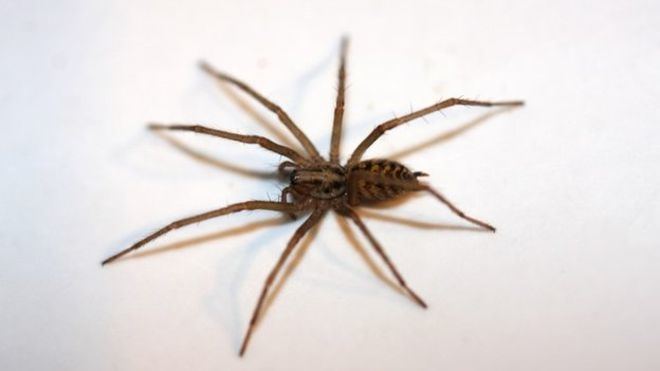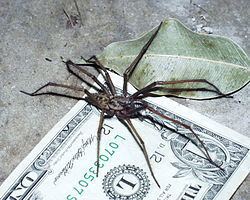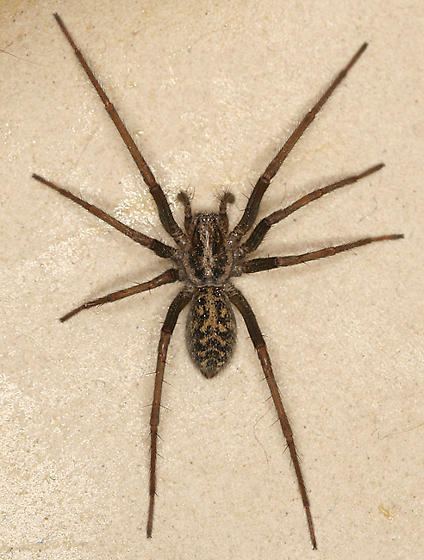Rank Species | Family Agelenidae Scientific name Eratigena atrica Higher classification Eratigena Order Spider | |
Similar Tegenaria, Tegenaria domestica, Hobo spider, Black house spider, Eratigena | ||
Giant house spider big spider in my house
The giant house spider, now with the scientific name Eratigena atrica, is one of the biggest spiders of Central and Northern Europe. It was previously placed in the genus Tegenaria, where in addition to Tegenaria atrica, it was also documented as Tegenaria duellica, Tegenaria gigantea and Tegenaria saeva, among others, all thought to be different species. It is now a member of the newly described genus Eratigena. The bite of this species does not pose a threat to humans or pets, and it is generally reluctant to bite, preferring to escape.
Contents
- Giant house spider big spider in my house
- Giant house spider handling uk
- Description
- Taxonomy
- Distribution and habitat
- Biology and behavior
- Relationship with Eratigena agrestis
- In popular culture
- References

Giant house spider handling uk
Description

The two sexes do not differ in coloration or markings. Its coloration is mainly dark brown. On its sternum is a lighter marking, with three light spots on each side. The opisthosoma features a lighter middle line with six "spots" on each side. The giant house spider has the same coloration as the domestic house spider, Tegenaria domestica; it has earthy tones of brown and muddy red or yellow. They also have conspicuously hairy legs, palps and abdomen. The female body size can reach 18.5 millimetres (0.73 in) in length, with males having a slightly smaller body at around 12 to 15 millimetres (0.47 to 0.59 in) in length. The female leg span is typically around 45 millimetres (1.8 in). The leg span of the male is highly variable, with spans between 25 to 75 millimetres (0.98 to 2.95 in) being common.
Its eight eyes are of equal size and are arranged in two rows. As the eyes contain fewer than 400 visual cells, E. atrica can probably only distinguish light and dark.
Taxonomy

The first description of a spider now assigned to this species was by Carl Ludwig Koch in 1843, under the name Tegenaria atrica. Other supposedly different species were described later, including Tegenaria saeva by John Blackwall in 1844, Tegenaria duellica by Eugène Simon in 1875 and Tegenaria gigantea by Ralph Vary Chamberlin and Wilton Ivie in 1935. T. gigantea was synonymized with T. duellica in 1978. The three remaining taxa have been regarded as distinct species, particularly in Britain. Thus Roberts (1995) provides distinguishing characters for T. atrica, T. duellica and T. saeva, as does Oxford (2008) for T. duellica (as T. gigantea) and T. saeva. Others consider these three as part of a single morphologically variable species, for which the oldest name, and hence the senior synonym, is T. atrica.
A phylogenetic study in 2013 concluded that Tegenaria, as then defined, was not monophyletic, and split off some species, including T. atrica, into the newly created segregate genus Eratigena.
Distribution and habitat
E. atrica is found in Europe, Central Asia and Northern Africa. It was unwittingly introduced to the Pacific Northwest of North America circa 1900 due to human activity and has strongly increased in numbers for the last century.
In the last few years the spider has been found in several European countries in which it was previously not recorded, like Estonia, Latvia and Lithuania. It is recorded in the checklist of Danish spider species.
The giant house spider's original habitat consists mostly of caves, or dry forests where it is found under rocks, but it is a common spider in people's homes.
Biology and behavior
The webs built by the giant house spider are flat and messy with a funnel at one end. They do not contain sticky threads. The spider lurks in the funnel until a small invertebrate happens to get trapped in the web, at which point the spider runs out and attacks it. They usually build their webs in corners (on both the floor and ceiling), between boxes in basements, behind cupboards, in attics, or any other area that is rarely disturbed by large animals, or humans. Often found near window openings.
E. atrica normally lives for two or three years, but lifetimes of up to six years have been observed. While the female only leaves its nest to feed, males can often be seen wandering around houses during the late summer and early autumn looking for a mate. Males can be found from July to October, adult females occur all year.
At least 60 spiderlings emerge from an egg sac. Unusual for spiders, they are subsocial at this stage: they remain together for about a month, but do not cooperate in prey capture. The amount of cannibalism correlates with the amount of available food. E. atrica molts seven or eight times before reaching the immature adult state, and after a final molt reaches maturity.
Like most spiders, the spider possesses venom to subdue its prey. Since E. atrica bites can penetrate human skin on occasion, the effects of agatoxin might be felt by bite victims, though these spiders will not bite unless provoked.
With speeds clocked at 1.73 ft/s (0.53 m/s) (1.18 mph), the giant house spider held the Guinness Book of World Records for top spider speed until 1987 when it was displaced by sun spiders (solifugids) although the latter are not true spiders as they belong to a different order.
Relationship with Eratigena agrestis
A population of giant house spiders is popularly thought to be a deterrent to the establishment of Eratigena agrestis, known in North America as the "hobo spider", and considered by some to be more likely to bite humans. Giant house spiders may compete with hobo spiders for the same resources. Hobo spiders grow no more than a body size of 15 millimetres (0.59 in) long whereas the larger female giant house spider can have a body size of 18 millimetres (0.71 in), but has proportionately much longer legs.
In popular culture
Humorist David Sedaris has written about his relationship with E. atrica. His essay "April In Paris" documents his growing affection towards and domestic association with giant house spiders, particularly one named April. The essay can be found in the collection When You Are Engulfed in Flames.
